MOQS ransomware used as a virtual extortion tool by STOP/DJVU operators
Contents
MOQS ransomware is recognized as variant of STOP/DJVU virus that is designed to encrypt all files on victim’s computer. For this task, the virus used RSA Salsa20 encryption algorithm. During the attack, the malware saves _readme.txt ransom note in every folder and marks each file with an additional .moqs extension. For example, file initially called 1.jpg will appear as 1.jpg.moqs after the virus affects it. The whole point of data encryption is to make it inaccessible for the victim and demand a ransom for its decryption. As explained in the ransom note, cybercriminals promise to decrypt .moqs files if the victim pays $490 within first three days or $980 later. The note also includes two emails – manager@mailtemp.ch or helpmanager@airmail.cc which the victim can use to contact the criminals.
The primary aim of MOQS ransomware is to “secure” victim’s files with military-grade encryption algorithms and keep them this way so that the victim can no longer access them. The malware is designed to encrypt the first 150 KB of each file. This is enough to corrupt files yet keep the whole attack process short. However, this encryption method also allows victims to repair certain data formats with some data loss at the beginning of the file as explained in this decrypt/repair STOP/DJVU files guide.

MOQS decryption tool price depends on how quickly the victim manages to arrange a deal with the criminals. They state that the victim needs to write and pay the ransom within 72 hours from the initial infection timestamp (the malicious program saves it on victim’s computer and also sends it to criminals Command and Control server). This guarantees a 50% discount on the ransom price and means that it will cost $490 to decrypt .moqs data. However, if the victim won’t manage to pay within the given timeframe, the decryption will cost $980 instead. An important detail to mention is that the attackers will ask to pay in Bitcoins rather than regular currency as this guarantees that the transaction will be untraceable and prevents hunting the attackers down. The _readme.txt file contents also include an encouragement to pay the ransom by suggesting test decryption service on one small file.
Our experts’ team as well as FBI suggest that paying the ransom is wrong choice. Here are a list of reasons why you shouldn’t do so:
- No matter how much you pay the criminals, there is no guarantee that criminals will do as they said and decrypt your files. Their sole aim is money, so after receiving it, they might simply stop replying to you.
- Criminals earn millions of US dollars each year from ransomware attacks. We encourage you to stop contributing to the growth of ransomware industry and not transfer your hard-earned money to attackers. Instead, we suggest investing in data backups to keep your files safely from now on.
- Remember that in some countries paying the ransom is as illegal as asking for it. Therefore, you might be breaking laws by paying the ransom.
- Viruses that belong to STOP/DJVU ransomware family such as MOQS virus run AZORULT Trojan on compromised systems. It is designed to steal valuable information such as passwords and other details that can be used to blackmail you further. We will provide more information about this threat later in this article.
Ransomware damage: what has been done to your computer, explained
MOQS ransomware arrives as a set of processes, each designed to perform various illegal modifications on your computer. One of the first ones that signals you’re infected with STOP/DJVU virus variant is called winnupdate.exe, a simple program that mimics Windows update prompt. We can tell you that it looks nothing like the real update screen as it is simple small window. However, the attackers use it to trick the victims into thinking that the computer is under some essential operating system updates that cause a sudden system slowdown. However, the slowdown is caused by data encryption process called by four-character executable file (for example, G6F5.exe). Another thing that this virus does is deleting Volume Shadow Copies from the system by running the following command in Command Prompt:
vssadmin.exe Delete Shadows /All /Quiet
Deleting VSS blocks victim’s attempts to use System Restore Points to restore computer to a previously saved state. Next modification is adding a list of domains to Windows HOSTS file. The virus maps them to victim’s localhost IP, which results in DNS_PROBE_FINISHED_NXDOMAIN error appearance when trying to access them via web browser (all of them). To explain this, it has been noticed that the virus attempts to block various computer-related domains that publish various cybersecurity-related information, how-to guides, virus removal instructions, and similar online communities (forums) where the victim could find some relevant information regarding the ransomware attack. The victim might also find some ransomware-dropped files on the computer that contain some information used to identify the victim – bowsakkdestx.txt (contains victim’s public encryption key and personal ID) and PersonalID.txt (only includes victim’s identification string). An example of the said file is shown in the image down below.

Victims of MOQS virus should beware that this ransomware doesn’t arrive as sole thing – it also runs a malicious information stealer called AZORULT Trojan on the compromised computer. It falls into Remote Access Trojan (RAT) category and cybercriminals can use it to remotely perform various illegal actions on victim’s PC, such as:
- Downloading malware to the computer and running it;
- Stealing Steam, Telegram login credentials;
- Viewing or deleting files on victim’s computer;
- Stealing cryptocurrency wallets;
- Stealing browser cookies, saved passwords, visited websites list and more.
We strongly recommend you to remove MOQS ransomware virus as quickly as possible as well as AZORULT Trojan it launched on your computer. To get rid of malware, consider using a professional security software such as INTEGO Antivirus. After that, we strongly recommend downloading RESTORO to repair virus damage on Windows OS files.
Ransomware Summary
| Name | MOQS Ransomware Virus |
| Type | Ransomware; Crypto-malware; Virtual Extortion Virus |
| Family | STOP/DJVU |
| Encryption type | RSA Salsa20 |
| Previous versions | KAAA, BGJS, BGZQ (find full list here) |
| Version | 316th |
| Extension | .moqs |
| Dropper | SmokeLoader (see VirusTotal details) |
| Damage | The ransomware is designed to encrypt all data on victim’s computer using RSA Salsa20 encryption algorithms. It marks each file with extra .moqs extension, saves _readme.txt notes and deletes VSS from the system using a command-line task. Additionally, the virus modifies Windows HOSTS file to block a set of domains. |
| Ransom note | _readme.txt |
| Ransom demand | $490-$980 in Bitcoin |
| Distribution | Hides in illegal torrent downloads, cracked software, key generators or tools like KMSPico. |
| Detection names | Trojan:Win32/Glupteba (Microsoft), VHO:Trojan-Spy.Win32.Stealer.gen (Kaspersky), Trojan.GenericKD.46653983 (BitDefender), Generic.mg.c7f79357026c3409 (FireEye , W32.Trojan.Gen (Webroot) see all detection name variations on VirusTotal |
| Removal | Remove ransomware and related malware from your PC using professional software of your choice. We highly recommend using INTEGO Antivirus. To repair virus damage on Windows OS files, consider scanning with RESTORO. |
REPAIR VIRUS DAMAGE
Scan your system for FREE to detect security, hardware and stability issues. You can use the scan results and try to remove threats manually, or you can choose to get the full version of software to fix detected issues and repair virus damage to Windows OS system files automatically. Includes Avira spyware/malware detection & removal engine.

Ransomware infection vectors explained
Speaking of STOP/DJVU ransomware variants such as MOQS virus, it has been noticed that cybercriminals tend to hide them in illegal torrent downloads, mostly various software cracks, keygens and similar. Victims who have been infected with this ransomware strain report downloading the file-encrypting menace from cracks of these popular programs:
- Adobe Photoshop;
- Corel Draw;
- Cubase;
- Adobe Illustrator;
- Windows activation tools such as KMSPico.
Cybercriminals behind this malware target people who are trying to get paid programs for free. Therefore, if you’re trying to bypass paying for legitimate software license, you risk ending up with no software but all personal data encrypted instead. We strongly recommend you to avoid using such wrong methods to get desired software and visit official developers’ websites instead to get safe program download links only. We can assure you that license fees rarely surpass hefty ransoms asked by cybercriminals.
Ransomware as well as other malware variants are also actively distributed using malicious spam campaigns. Nowadays, one of the easiest methods to target loads of potential victims is sending specifically modified documents to them via email. Therefore, cybercriminals have been leveraging this technique for as long as we can remember. Injecting a malicious payload-downloading script into popular file formats such as DOCX, XLS or PDF allows criminals to disguise their intentions. In addition, they name these files as invoice/pending payment/parcel delivery tracking details or similarly to make the document look safe. Sadly, these file formats allow adding JavaScript or Macros that allow activation of the malicious code immediately after the victim opens the file and/or disables Protected Mode in them. As identifying malicious emails can be tricky nowadays, we provide a list of “red signs” that you should look for when opening a suspicious email:
- Urgent message tone and suggestions to open attached contents immediately;
- Claims about an invoice or another important document that needs to be reviewed instantly;
- The sender pretends to be someone from a well-known company;
- Spoofed email address;
- Your email box provider marks the letter as spam.
To stay on the safe side, we recommend ignoring emails that you didn’t expect to receive. For example, if you weren’t waiting for invoice from a specific company or if you aren’t expecting a parcel to reach you, do not open emails that claim you need to view attached files regarding the matter.
We must also inform you about another stealthy attack technique that ransomware distributors use. They tend to hide malware in fake decryption tools. One example is ZORAB malware that hides in fake STOP/DJVU ransomware decryption tools. Criminals know the popularity of this virus and use it to trick the victims into downloading a second payload only to have their files double-encrypted instead of recovering them.
Remove MOQS ransomware and decrypt your files
Remove MOQS ransomware virus safely using instructions provided by our team. First, you will need to use the guide given below to boot your computer in Safe Mode with Networking and eliminate the malware using professional software of your choice. For virus removal, we recommend using INTEGO Antivirus, which also provides robust real-time protection. Finally, download RESTORO and scan your PC to repair virus damage on Windows OS files.
As soon as you complete MOQS ransomware virus removal, consider taking recommended actions:
- Find your local cybersecurity authority and report that you’re fallen victim to a ransomware attack.
- Look for data backups created previously and use them to restore as many files as possible.
- Follow the given instructions to decrypt or repair files affected by STOP/DJVU versions.
- We also recommend changing your passwords, especially for sites that you chose to save login credentials for in your browser.
OUR GEEKS RECOMMEND
Our team recommends removing malware using a professional antivirus software.
REMOVE THREATS WITH ROBUST ANTIVIRUS

Get INTEGO ANTIVIRUS for Windows to remove ransomware, Trojans, adware and other spyware and malware variants and protect your PC and network drives 24/7. This VB100-certified security software uses state-of-art technology to provide protection against ransomware, Zero-Day attacks and advanced threats, Intego Web Shield blocks dangerous websites, phishing attacks, malicious downloads and installation of potentially unwanted programs.
Use INTEGO Antivirus to remove detected threats from your computer.
GeeksAdvice.com editors select recommended products based on their effectiveness. We may earn a commission from affiliate links, at no additional cost to you. Learn more.
MOQS ransomware virus Removal Guidelines
Method 1. Enter Safe Mode with Networking
Step 1. Start Windows in Safe Mode with Networking
Before you try to remove MOQS ransomware virus virus, you must start your computer in Safe Mode with Networking. Below, we provide the easiest ways to boot PC in the said mode, but you can find additional ones in this in-depth tutorial on our website – How to Start Windows in Safe Mode. Also, if you prefer a video version of the tutorial, check our guide How to Start Windows in Safe Mode on Youtube.
Instructions for Windows XP/Vista/7 users
- First of all, turn off your PC. Then press the Power button to start it again and instantly start pressing F8 button on your keyboard repeatedly in 1-second intervals. This launches the Advanced Boot Options menu.
- Use arrow keys on the keyboard to navigate down to Safe Mode with Networking option and press Enter.

Instructions for Windows 8/8.1/10/11 users
- Open Windows Start menu, then press down the Power button. On your keyboard, press down and hold the Shift key, and then select Restart option.

- This will take you to Windows Troubleshoot screen. Choose Troubleshoot > Advanced Options > Startup Settings > Restart. Tip: If you can't find Startup Settings, click See more recovery options.

- In Startup Settings, press the right key between F1-F9 to enter Safe Mode with Networking. In this case, it is the F5 key.

Step 2. Remove files associated with the virus
Now, you can search for and remove MOQS ransomware virus files. It is very hard to identify files and registry keys that belong to the ransomware virus, Besides, malware creators tend to rename and change them repeatedly. Therefore, the easiest way to uninstall such type of a computer virus is to use a reliable security program such as INTEGO Antivirus. For virus damage repair, consider using RESTORO.
Special Offer
Compatibility: Microsoft Windows
See Full Review
RESTORO is a unique PC Repair Tool which comes with an in-built Avira scan engine to detect and remove spyware/malware threats and uses a patented technology to repair virus damage. The software can repair damaged, missing or malfunctioning Windows OS files, corrupted DLLs, and more. The free version offers a scan that detects issues. To fix them, license key for the full software version must be purchased.
Method 2. Use System Restore
In order to use System Restore, you must have a system restore point, created either manually or automatically.
Step 1. Boot Windows in Safe Mode with Command Prompt
Instructions for Windows XP/Vista/7 users
- Shut down your PC. Start it again by pressing the Power button and instantly start pressing F8 button on your keyboard repeatedly in 1-second intervals. You will see Advanced Boot Options menu.
- Using arrow keys on the keyboard, navigate down to Safe Mode with Command Prompt option and press Enter.

Instructions for Windows 8/8.1/10/11 users
- Launch Windows Start menu, then click the Power button. On your keyboard, press down and hold the Shift key, and then choose Restart option with the mouse cursor.

- This will take you to Windows Troubleshoot screen. Choose Troubleshoot > Advanced Options > Startup Settings > Restart. Tip: If you can't find Startup Settings, click See more recovery options.

- In Startup Settings, press the right key between F1-F9 to enter Safe Mode with Command Prompt. In this case, press F6 key.

Step 2. Start System Restore process
- Wait until system loads and command prompt shows up.
- Type cd restore and press Enter, then type rstrui.exe and press Enter. Or you can just type %systemroot%system32restorerstrui.exe in command prompt and hit Enter.

- This launches System Restore window. Click Next and then choose a System Restore point created in the past. Choose one that was created before ransomware infection.

- Click Yes to begin the system restoration process.
After restoring the system, we recommend scanning the system with antivirus or anti-malware software. In most cases, there won't be any malware remains, but it never hurts to double-check. In addition, we highly recommend checking ransomware prevention guidelines provided by our experts in order to protect your PC against similar viruses in the future.
Alternative software recommendations
Malwarebytes Anti-Malware
Removing spyware and malware is one step towards cybersecurity. To protect yourself against ever-evolving threats, we strongly recommend purchasing a Premium version of Malwarebytes Anti-Malware, which provides security based on artificial intelligence and machine learning. Includes ransomware protection. See pricing options and protect yourself now.

System Mechanic Ultimate Defense
If you're looking for an all-in-one system maintenance suite that has 7 core components providing powerful real-time protection, on-demand malware removal, system optimization, data recovery, password manager, online privacy protection and secure driver wiping technology. Therefore, due to its wide-range of capabilities, System Mechanic Ultimate Defense deserves Geek's Advice approval. Get it now for 50% off. You may also be interested in its full review.

Disclaimer. This site includes affiliate links. We may earn a small commission by recommending certain products, at no additional cost for you. We only choose quality software and services to recommend.
Decrypt MOQS files
Fix and open large MOQS files easily:
It is reported that STOP/DJVU ransomware versions encrypt only the beginning 150 KB of each file to ensure that the virus manages to affect all files on the system. In some cases, the malicious program might skip some files at all. That said, we recommend testing this method on several big (>1GB) files first.
- Create a copy of encrypted file to a separate folder using Copy > Paste commands.
- Now, right-click the created copy and choose Rename. Select the MOQS extension and delete it. Press Enter to save changes.
- In the prompt asking whether you want to make the changes as file might become unusable, click OK.
- Try opening the file.
STOP/DJVU decryption tool usage guide
STOP/DJVU ransomware versions are grouped into old and new variants. MOQS ransomware virus is considered the new STOP/DJVU variant, just like KAAA, BGJS, BGZQ (find full list here). This means full data decryption is now possible only if you have been affected by offline encryption key. To decrypt your files, you will have to download Emsisoft Decryptor for STOP DJVU, a tool created and maintained by a genius security researcher Michael Gillespie.
Note! Please do not spam the security researcher with questions whether he can recover your files encrypted with online key - it is not possible.
In order to test the tool and see if it can decrypt MOQS files, follow the given tutorial.
- Download the decryption tool from Emsisoft.
- Click the little arrow next to your download and choose Show in Folder.
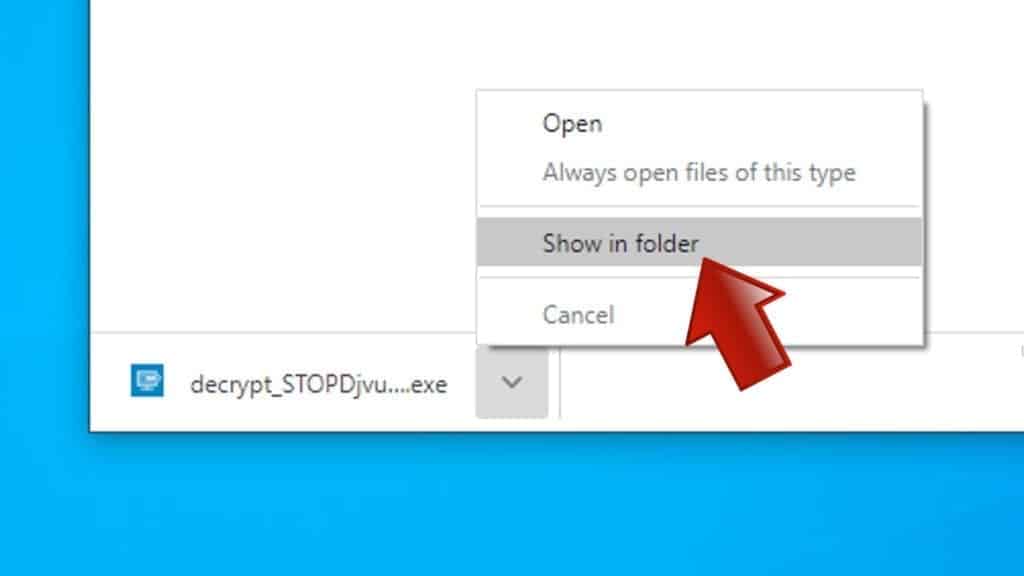
- Now, right-click the file and choose Run as Administrator. If asked, enter administrator's password.
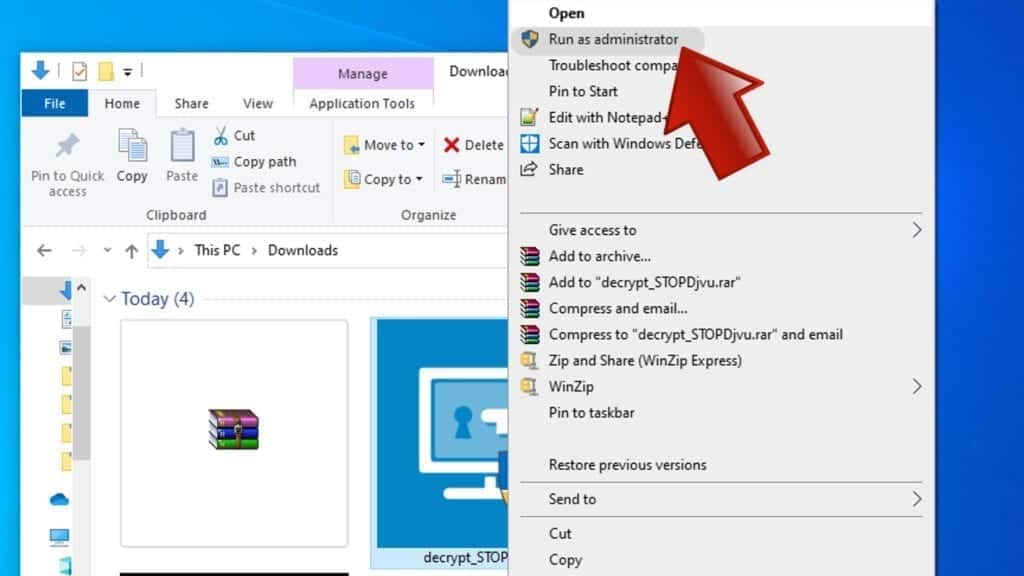
- In UAC window, click Yes.
- Click Yes to agree to software terms in both windows.
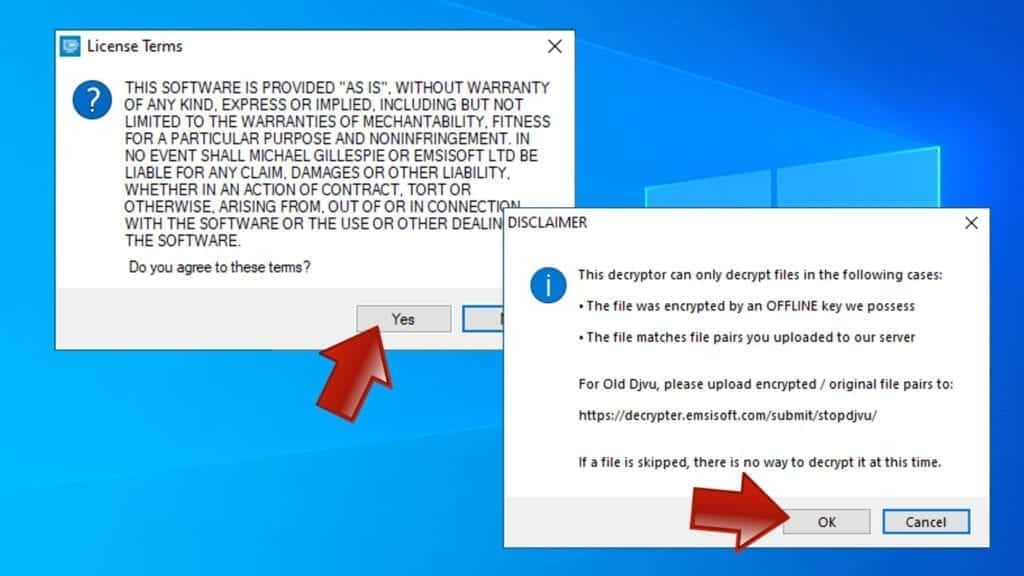
- The tool will automatically include C:// disk as a location to decrypt. The file recovery tool will prepopulate the locations to scan, including connected data storage drives or network drives. Click Add folder if you wish to add additional locations.
In Options tab, you can choose to keep encrypted file copies. We recommend leaving this option selected, especially if you do not know if the decryption tool will work.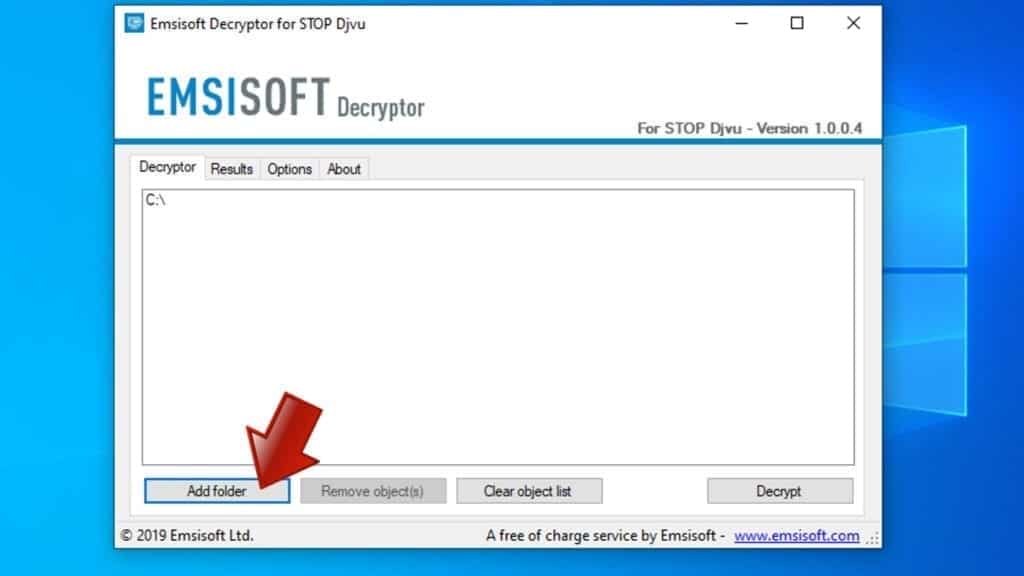
- Click Decrypt to start restoring MOQS files. You will see the progress in the Results tab. Here, you can see messages from the tool, such as whether the decryption procedure is successful, or you need to wait for an update.
You might also be informed that online key was used to encrypt your files. In such case, the decryption tool won't work for you, and the only way to recover your files is to use a data backup.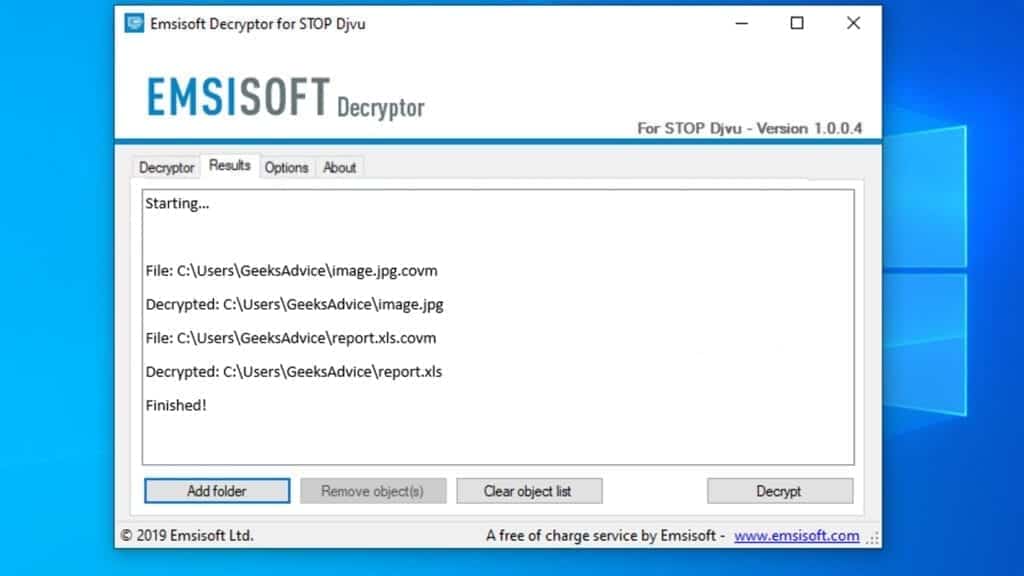
Meanings of decryptor's messages
The MOQS decryption tool might display several different messages after failed attempt to restore your files. You might receive one of the following messages:
Error: Unable to decrypt file with ID: [example ID]
This message typically means that there is no corresponding decryption key in the decryptor's database.
No key for New Variant online ID: [example ID]
Notice: this ID appears to be an online ID, decryption is impossible
This message informs that your files were encrypted with online key, meaning no one else has the same encryption/decryption key pair, therefore data recovery without paying the criminals is impossible.
Result: No key for new variant offline ID: [example ID]
This ID appears to be an offline ID. Decryption may be possible in the future.
If you were informed that an offline key was used, but files could not be restored, it means that the offline decryption key isn't available yet. However, receiving this message is extremely good news, meaning that it might be possible to restore your MOQS extension files in the future. It can take a few months until the decryption key gets found and uploaded to the decryptor. We recommend you to follow updates regarding the decryptable DJVU versions here. We strongly recommend backing up your encrypted data and waiting.
Report Internet crime to legal departments
Victims of MOQS ransomware virus should report the Internet crime incident to the official government fraud and scam website according to their country:
- In the United States, go to the On Guard Online website.
- In Australia, go to the SCAMwatch website.
- In Germany, go to the Bundesamt für Sicherheit in der Informationstechnik website.
- In Ireland, go to the An Garda Síochána website.
- In New Zealand, go to the Consumer Affairs Scams website.
- In the United Kingdom, go to the Action Fraud website.
- In Canada, go to the Canadian Anti-Fraud Centre.
- In India, go to Indian National Cybercrime Reporting Portal.
- In France, go to the Agence nationale de la sécurité des systèmes d’information.
If you can't find an authority corresponding to your location on this list, we recommend using any search engine to look up "[your country name] report cyber crime". This should lead you to the right authority website. We also recommend staying away from third-party crime report services that are often paid. It costs nothing to report Internet crime to official authorities.
Another recommendation is to contact your country's or region’s federal police or communications authority.
Frequently Asked Questions
You can only open MOQS files if you have the decryption key, or if you were affected by offline encryption type.
To figure out whether you were affected by offline encryption, please go to C:/SystemID/PersonalID.txt and see if the string inside of it ends in t1. You can also try using Emsisoft Decryptor for STOP/DJVU.
Please follow the guidances provided by the official MOQS decryption tools and believe what they say. If they say it is impossible to decrypt, it really is so. There is no magic tool or human capable of decrypting your files hiding somewhere. Encryption is a technique created to be nearly impossible to decrypt without a special private key (held by the criminals).
We advise scanning with anti-virus, anti-malware, malware removal tools or software like RESTORO to eliminate virus damage on the system. If you do not trust using a single tool, try running one after another. However, we do not recommend keeping several security programs on a computer at once as they can interfere with each other's work.
Beware of fake MOQS decryption tools circulating around the web. Cyber criminals are uploading them to various shady websites, also might be promoting them via suspicious Youtube videos. These programs can infect your computer even more heavily (Trojans, miners, etc.). We suggest being extremely cautious around the web. If there will be an official STOP/DJVU decryption tool available, it will be widely discussed in public media.

Norbert Webb is the head of Geek’s Advice team. He is the chief editor of the website who controls the quality of content published. The man also loves reading cybersecurity news, testing new software and sharing his insights on them. Norbert says that following his passion for information technology was one of the best decisions he has ever made. “I don’t feel like working while I’m doing something I love.” However, the geek has other interests, such as snowboarding and traveling.
Leave a Reply